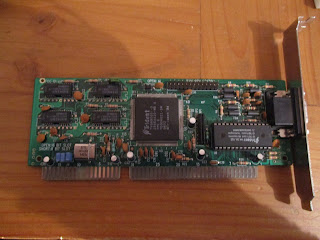Building an input register Pt 1
For various reasons (well... one) I suddenly find myself with a lot of inside time to fill. I realised I hadn't written anything here for a while, so I've decided to write about some things that got done a while ago.
Starting with this: An input device for my SAP 1 breadboard computer!
Most SAP 1 designs don't include input, except for something to enter programs, but a computer is much less useful if you can't give it parameters.
Following on from the simple design goals I've decided to use TTL era logic for this. Well, except for one chip: a 74C922 - keyboard decoder. These are quite old now, but can still be got from surplus suppliers.
This chip scans a 16 key keyboard and outputs a 4 bit binary value corresponding to the pressed key.
Originally I was going to latch this into one 4 bit latch with a second connected to the outputs... this changed a little during design (see later)
Firstly I'd need a keyboard. There are lots of 4 x 4 matrix keyboards on ebay, but none have the required 0-9 and a-f I wanted. So I decided to repurpose this remote control I had lying around.
Firstly I needed to get rid of the control electronics...
The board is all through hole which made the job easier, only 1 IC and a few discrete components.
These were quickly removed, and the board contacts and buttons cleaned, leaving the PCB ready.
It's not clear. but the 16 numbered buttons are in a 4x4 matrix like I need. Tracing these back to the IC footprint provided convenient soldering locations.
A quick reassembly and test with the '922
Success! I brought the wires out through the battery compartment, so I could reassemble the case.
Next to build the actual register, which will be in part 2.
Starting with this: An input device for my SAP 1 breadboard computer!
Most SAP 1 designs don't include input, except for something to enter programs, but a computer is much less useful if you can't give it parameters.
Following on from the simple design goals I've decided to use TTL era logic for this. Well, except for one chip: a 74C922 - keyboard decoder. These are quite old now, but can still be got from surplus suppliers.
This chip scans a 16 key keyboard and outputs a 4 bit binary value corresponding to the pressed key.
Originally I was going to latch this into one 4 bit latch with a second connected to the outputs... this changed a little during design (see later)
Firstly I'd need a keyboard. There are lots of 4 x 4 matrix keyboards on ebay, but none have the required 0-9 and a-f I wanted. So I decided to repurpose this remote control I had lying around.
The board is all through hole which made the job easier, only 1 IC and a few discrete components.
These were quickly removed, and the board contacts and buttons cleaned, leaving the PCB ready.
Success! I brought the wires out through the battery compartment, so I could reassemble the case.
Next to build the actual register, which will be in part 2.







Comments
Post a Comment